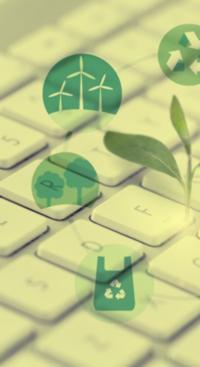What is digital pollution?
Digital pollution refers to all the environmental impacts associated with the IT sector, whether in the manufacture, use or recycling of digital equipment and services.
According to ADEME, digital pollution accounts for up to 2.5% of total CO2 emissions in France, and could rise to 7% by 2040. On a global scale, according to a report by The Shift Project, in 2018 digital was responsible for almost 4% of global greenhouse gas emissions.
But digital pollution is not limited to CO2: it also concerns the consumption of water, energy and resources, as well as the production of electronic waste.
What are the main factors behind digital pollution?
Digital pollution comes from three main sources: terminals, networks and data centers.
- Of these sources, terminals (smartphones, computers, tablets, televisions, etc.) are the most polluting, as they require a lot of raw materials (rare metals, plastics, etc.) and energy to manufacture. According to a joint study by ADEME and ARCEP, terminals generate between 65% and 92% of the environmental impact of the digital sector in France.
- Data centers, which store and process data on computer servers, are the second biggest source of digital pollution, accounting for between 4% and 20% of environmental impact.
- Networks, which enable data transmission between terminals and data centers, are the third source of digital pollution, accounting for between 4% and 13% of environmental impact.


Key figures that make you think
According to the Prospective assessment of the environmental impact of digital technology in France, jointly conducted by ADEME and ARCEP and published in March 2023, in the context of continued growth in uses at the current rate, if we don’t take action by 2030 to reduce the ecological impact of digital technology, the volume of data could be multiplied by 6 and the number of devices would increase by almost 65% compared to 2020, mainly due to the growing popularity of connected objects.
Between 2020 and 2030, this could lead to
- Increase in France’s digital carbon footprint: around +45% (to 25 Mt CO2eq)
- Increased consumption of abiotic resources (metals and minerals): +14%.
- Increase in end-user electricity consumption: + 5% (to reach 54 TWh per year).
And identified drivers perfectly aligned with Green WiFi
To reduce the environmental impact of the digital sector by 2030, Ademe and Arcep have proposed a number of measures.
- It is stressed that, in addition to the carbon footprint, a major challenge for the digital sector is the availability of strategic metals and other resources needed to manufacture terminals, notably TV sets, computers, internet boxes, smartphones and connected objects.
- A “digital sobriety” approach is recommended, starting with a reflection on the need to develop new digital products or services, and aiming to reduce or stabilize the number of devices. It is recommended to extend the lifespan of terminals by encouraging reconditioning and repair, while raising consumer awareness of these practices.
- Ecodesign is also highlighted as a means of improving energy efficiency, covering not only terminals, but also all equipment (network infrastructures and data centers), as well as the deployment methods for digital networks and services.
Implementing these measures could lead to a reduction in the environmental footprint of digital by 2030, with a potential reduction of up to 16% in carbon footprint compared to 2020.
The Green WiFi approach is perfectly in line with the direction indicated by these levers for action to reduce the environmental impact of digital technology.
By promoting ecodesign, extending equipment lifecycles and raising user awareness of the challenges of digital sobriety, Green WiFi is actively contributing to this transition to a more environmentally-friendly digital world.
Reducing digital pollution is everyone's business
Faced with these alarming figures, it’s urgent to adopt simple, effective measures to reduce digital pollution. The alert is not new, but it really is time to get started. Here are a few practical tips you can apply to yourself on a daily basis:
To go further in reducing your carbon footprint, for yourself or your company.
Numerous initiatives and online platforms are committed to raising awareness of the challenges of digital pollution among individuals and businesses alike.
Their main mission is to make good practices in digital sobriety accessible to all, while striving to alert and closely study all associated issues. We strongly advise you to consult :
Green WiFi to support the ecological transition of businesses


While the little things we do on a daily basis concern us all, and are easy to put in place, the steps companies need to take are much more complex, and subject to restrictive regulations.
Against this backdrop, Green WiFi is committed to helping all businesses reduce their digital pollution by offering sustainable, energy-efficient solutions. By promoting the energy efficiency of networks and raising our customers’ awareness of good digital practices, we are helping to reduce the carbon footprint of the digital age.
In addition, by supporting businesses in their choice of technologies and promoting responsible network infrastructures, we encourage the transition to a more sustainable digital model.
